
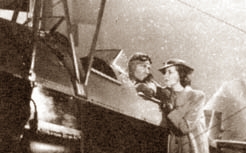
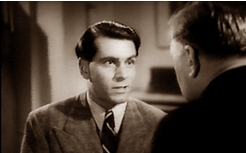
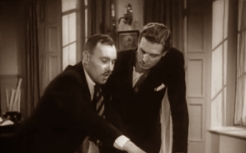

Q Planes (1939)
| Production Company: | Irving Asher Productions, originally released through Columbia Pictures |
| Director: | Tim Whelan |
| Arthur B. Woods | |
| Writers: | Brock Williams |
| Jack Whittingham | |
| Arthur Wimperis | |
| Ian Dalrymple | |
| Cast: | Laurence Olivier (Tony McVane) |
| Ralph Richardson (Major Charles Hammond) | |
| Valerie Hobson Kay Lawrence | |
| George Curzon (Jenkins) | |
| George Merritt (Mr. Barrett) | |
| Gus McNaughton (Blenkinsop, the butler) | |
| Sandra Storm (Daphne) |
This humorous espionage thriller refuses to take itself too seriously. It is very much a precursor to the James Bond films of the 1960s, likely because it was co-written by Jack Whittingham, who later helped create the film version of Bond. Whittingham was one of the principal architects of Thunderball (1965), originally intended to be the first 007 picture. Many classic Bond elements are found in Q Planes, including bringing down planes electronically (as in Dr. No), memorably quirky characters, tongue-in-cheek humour and a big battle at the end. Its influence extended even further than Bond; Patrick Macnee says he based his charming, offbeat John Steed character from 1960s TV classic series The Avengers on Ralph Richardson's scene-stealing portrayal in this film.
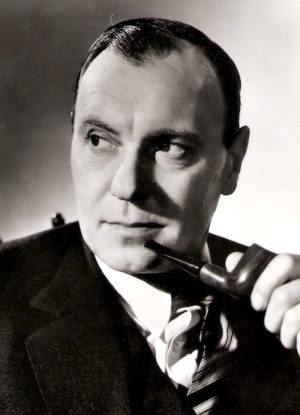
One of the most entertaining aspects of British cinema is the wonderful vein of eccentricity that so often pops up and flows through their films. In countless movies, eccentrics are featured as memorable supporting players (remember the two obsessive football fanatics who leaven suspense with humour in Hitchcock’s The Lady Vanishes?). In other films – Margaret Rutherford’s Miss Marple series or Alec Guinness’ Gully Jimson in The Lady Vanishes? come to mind – the eccentric is actually the main character. No one played British eccentrics better than RALPH RICHARDSON, for no one played them more wholeheartedly. Not only was he one of the twentieth century’s finest actors – Richardson was truly one of its finest 100% genuine eccentric people. He once stopped abruptly in a middle of a stage performance, turned to the audience and enquired, “Is there doctor in the house?” When a doctor identified himself, Richardson calmly enquired, “Isn't this a terrible play, Doctor?” When approached to play a central role in 1966’s The Wrong Box, Richardson’s only request was that he be allowed to wear the same overcoat he had just worn in the film Dr. Zhivago (he could, and did). His eccentricity wasn’t an act; it was real, and it stemmed largely from his innate, boundless curiosity and playfulness. It was an outlet, and it helped form an essential, very lively part of his enormous talent.
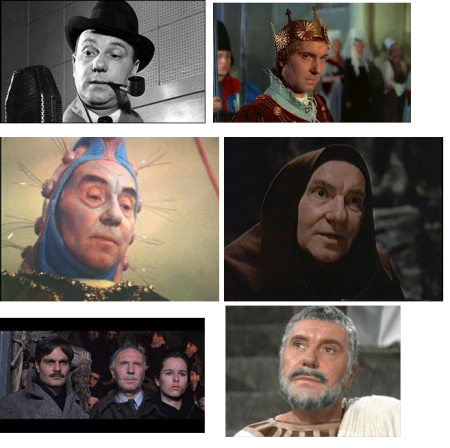
Unlike many other actors, including co-star Laurence Olivier, Richardson did not have good looks to fall back upon. He was tall, but plain. Early in his career, unfriendly theatre critics criticized him for not always “looking the part” of a leading man, and it stung. “I don't like my face at all,” he lamented. “It's always been a great drawback to me.” No matter, for he had more than enough talent, personality and energy to make up for his looks. His ordinary appearance actually made him a much more effective character actor, and as he aged, of course, it just didn’t matter. Lifelong stage work brought him enormous acclaim. Ralph Richardson was the first actor of his generation to be knighted. He was dubbed Sir Ralph in 1947, quickly followed by Laurence Olivier in 1948 and John Gielgud in 1953. These three theatrical knights were widely considered the greatest English actors of their generation, primarily for their mastery of Shakespearean roles. They were frequent collaborators and very good friends. In the 1940s, Richardson and Olivier jointly ran the Old Vic Company in London.
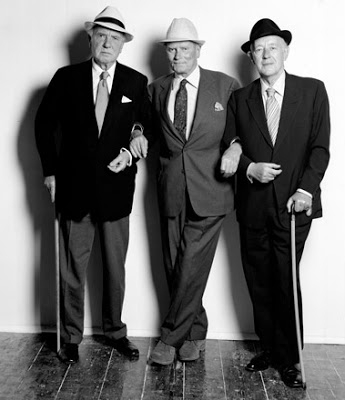
Though some stage actors dislike making movies, Richardson embraced them. “I've never been one of those stage chaps who scoff at films,” he said. “I think they're a marvelous medium, and are to the stage what engravings are to paintings.” His film debut came in 1933’s The Ghoul, the first British horror film of the sound era. He was fully aware that a different medium required a different approach: “Acting on the screen is like acting under a microscope. The slightest movement becomes a gesture, and therefore the discipline has to be very severe.” Richardson knew his craft inside out, viewing it both prosaically (“The art of acting lies in keeping people from coughing”) and poetically (“Acting is the ability to dream on cue”). He also fully recognized the actor’s sometimes tenuous relationship with his real identity: “I have put on so many make-ups that sometimes I have feared that when I go to wipe it off there will be nobody left underneath.”
Richardson’s long, prolific career led him to many unexpected places, which was part of the fun of it. While visiting Toronto in the 1980s, Richardson was thrilled to take a spin on one of the city’s fire engines, with siren blaring (he was a lifelong collector of motorcycles, and delighted in driving fast). In December, 1976, he and Sir John Gielgud surprised the audience of Canadian TV’s groundbreaking comedy series SCTV when they made a joint guest appearance (yes, really; two knights of the realm on SCTV). Their sketch – in which they played themselves – found them waiting in a dressing room, bantering excerpts from the Harold Pinter vignette “Crosswords” back and forth.
“Actors never retire; they just get offered fewer parts,” Richardson once observed. Nonetheless, he remained in demand, kept busy and worked until the end – and then some. His last two films, Give My Regards to Broad Street and Greystoke: The Legend of Tarzan, King of the Apes were released posthumously, in 1984. Sir Ralph had died as the result of a stroke in 1983, at the age of 80. He left his second wife, actress Meriel (“Mu”) Forbes, and their son, Charles. Richardson had been widowed in 1942, when his first wife, actress Muriel (“Kit”) Hewitt, died after a long, sad struggle with encephalitis (a.k.a. Sleeping Sickness).
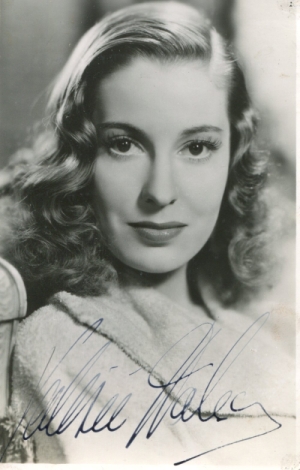
Tall, serene beauty VALERIE HOBSON graced many fine British films of the 1930s and ‘40s. She also made several during a year spent visiting Hollywood (disillusioned there, she was glad to go home). In the U.S., she is best remembered for two classic horror films, both made in 1935: Bride of Frankenstein and Werewolf of London.
British fans remember her for performances in much different classics: as cold yet alluring Estella in Great Expectations (1946) and virtuous Edith D’Ascoyne in Kind Hearts and Coronets (1949). She also performed in an American version of Great Expectations (1934), but her part – Biddy, that time – was cut due to the film’s length.
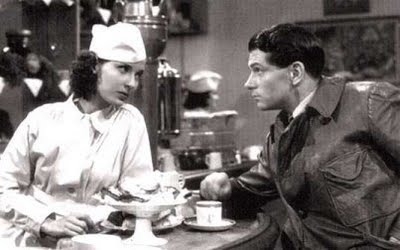
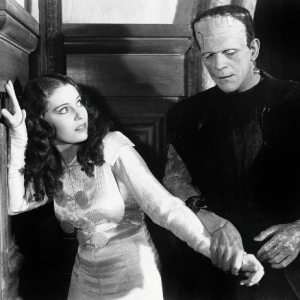
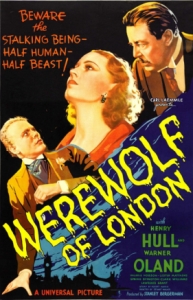
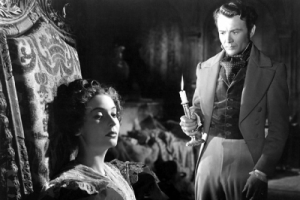
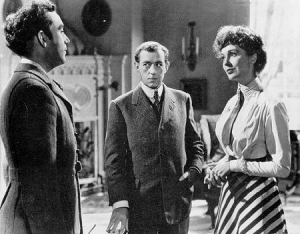
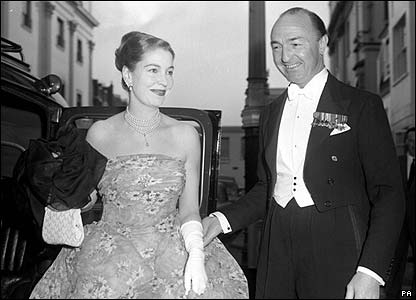
In 1939, she married producer Sir Anthony Havelock-Allan, and subsequently appeared in many of his films. The couple had two sons before divorcing in 1952. Hobson retired from acting in 1954, after marrying her second husband, Conservative MP John Profumo. For seven years, she lived the quietly genteel life of a successful politician’s wife. Then her life went off the rails in spectacular fashion, and the former movie star faced the public in an entirely different light.
In 1961, a particularly touchy time in the Cold War, Profumo was serving in a very sensitive position – Secretary of State for War. He was also a member of the Privy Council. That summer, he had an affair with a young model/party girl named Christine Keeler. Politics is a very gossipy business, and rumours about the affair soon began to circulate. When it was revealed that Christine Keeler had been sleeping with the Soviet embassy’s senior naval attaché at the same time, the emerging “Profumo Affair” took on serious national security dimensions. Laden with scandal, sex and spies, and covered extensively and enthusiastically by the tabloid press, it is still considered Britain’s all-time biggest political scandal. Profumo's ministerial career ended in disgrace in 1963, following revelations he had lied to the House of Commons about the affair. Lying to Parliament is an unforgivable offence in Britain. Profumo resigned from office and quit politics altogether. Deeply shaken, he felt a great need to atone. He was able to live on his inherited wealth, so he went to work as a volunteer at Toynbee Hall, a community centre deep in the neediest of neighborhoods – and he worked there, gratis, for the rest of his life. As author Peter Hitchens wrote, Profumo “vanished into London's East End for 40 years, doing quiet good works.” He began as a janitor, but was eventually “persuaded to lay down his mop and lend a hand running the place.” In time, Profumo became Toynbee Hall’s chief fundraiser, greatly relieved to find a way to use his formidable political skills for a good, unselfish cause.
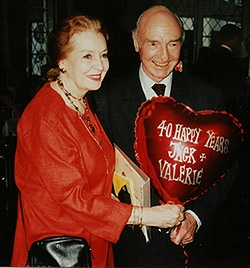
Through it all, Valerie Hobson stood by him. Profumo had confessed the affair to her before it became public knowledge, and she forgave him. She also joined him by devoting the rest of her life to charitable causes. In addition to their work together on behalf of Toynbee Hall, she devoted most of her personal efforts to alleviate leprosy. Their new life wasn’t easy; she admitted she missed their old, more public life. But, over time, their charity work earned them new and different respect than they had known in their glamourous former lives.
Hobson's eldest son, Simon, was born in 1944 with Down's Syndrome. Her second son, Mark Havelock-Allan, became a judge. In 2006, her youngest child, author David Profumo, wrote Bringing the House Down: a Family Memoir about the Profumo Affair. In it, he said his parents told him nothing of the scandal, leaving him to learn of it from another boy at school. (Hmm. What is that they say about charity beginning at home?) In 1998, Hobson decided to stop taking the medication for her heart condition. This soon led to the heart attack that killed her, at 81. John Profumo lived and worked diligently on until his death in 2006 at 91, two days after a stroke.
Notes by Paddy Benham